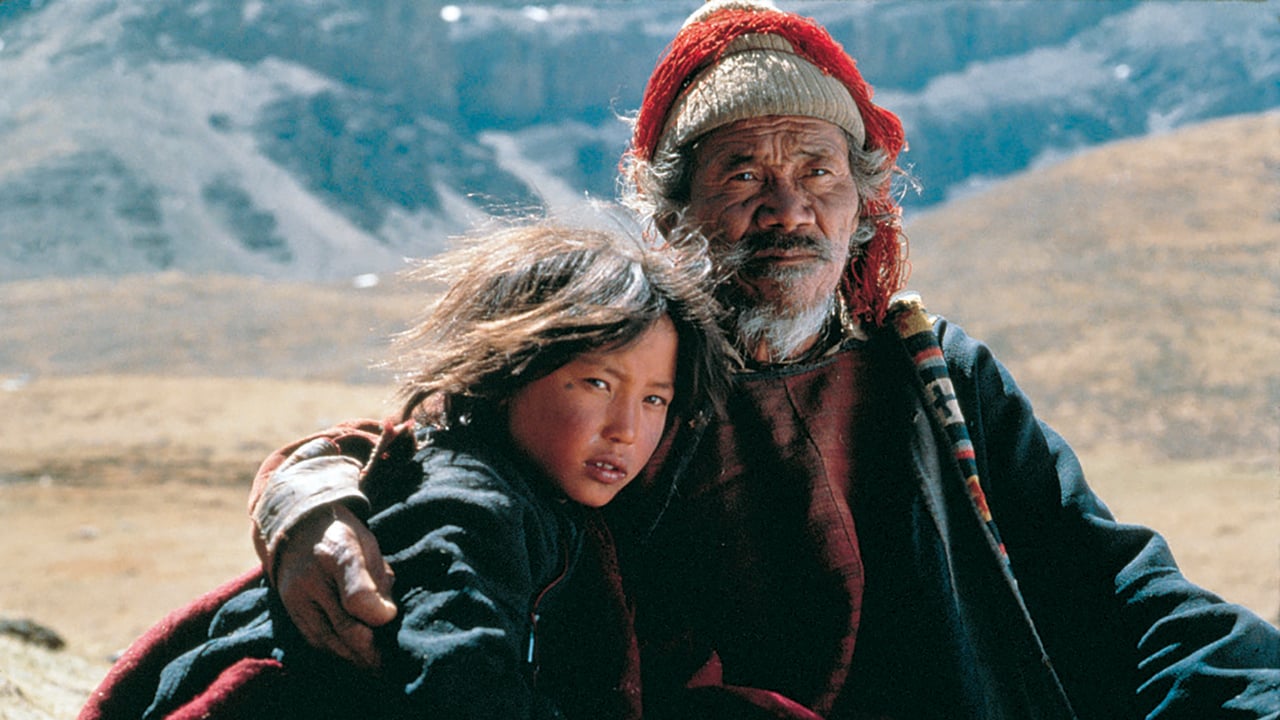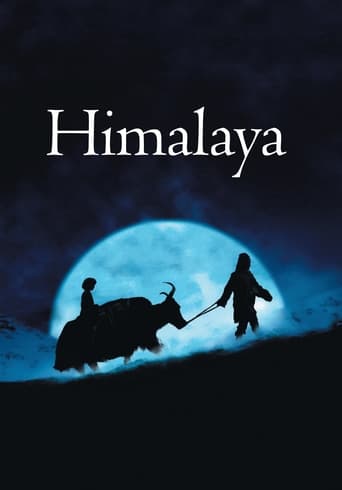

This is a superb example of the film genre which originally did most to establish cinematography as an important new art medium - it is a visually very striking tribute to a traditional lifestyle that is most unlikely to be able to continue for very much longer, and that would be lost forever if not recorded on film. Even back when feature films were still regarded as only poor shadows of stage presentations such films had already established themselves as a unique and irreplaceable adjunct to written or hand drawn records.For many years documentaries were probably the type of film most extensively made and, although the development of lightweight equipment that could be used in all weathers only took place very slowly, many anthropologically important works such as "Nanook of the North" or "Legong - Dance of the Virgins" began to appear soon after WW-I. Some were true documentaries where the photographer tried not to interfere with the normal activity pattern of his subjects, whilst in others the cast are deliberately acting out such activities for the exclusive benefit of the camera. Nanook of the North is an example of the former group whilst Dance of the Virgins has a story line built around the traditional ritual dances that are the principal cultural activity of the Balinese villagers who acted in the film. Himalaya is also an example of this latter type of documentary. It features the people of the Dolpo region, a high altitude plateau situated on the border between Nepal and Tibet in the Himalayas and so remote that its population appears to have only been estimated (somewhere between 5,000 and 18,000 according to Wikipedia). At an altitude of around 4,000 m this is one of the highest agricultural areas in the world with poor mountain soil, extremes of weather and a very short growing season, so not surprisingly the communities living there need to supplement their own food production through trading. For many centuries the traditional method has been to take salt (plentiful in Tibet) to Nepal by an annual Yak caravan trek across the mountains following the primitive trails developed to permit such trade, and to exchange this salt for grain. When Eric Valli made his documentary in 1999 this traditional practice was still being followed in a way unchanged for many centuries, but he appreciated that it was a fragile lifestyle and wanted to capture it for the world in case it came under threat. Since then a two prong threat has developed - the absorption of Tibet by the Peoples Republic of China has led to attempts to close the Nepalese Tibetian border which makes it harder for the Dolpo people to acquire the salt needed to continue this form of trade, and alternative sources of salt from other parts of the world have reduced the dependence of the Nepalese on the Dolpo caravans. It is hard to be optimistic that major changes will not become inevitable - a poignant concern whilst watching this beautiful film..Valli's team must have spent a long time getting to know the community and achieving a concensus on the story which would be presented. The final product is so realistic and documentary in effect that one almost feels it must be auto-biographical, but I believe this is unlikely as it would then have threatened to re-open the conflicts shown with potentially disastrous effects. It is much more likely to be a re-creation of legends and oral history from sometime in the past. It features an aged tribal leader Tinli, whose family has held this position for many generations, ready to hand over to his son just when the young man is killed in an accident. We learn that the role of tribal leader is not quite the hereditary right of this family, being subject to community approval which is based on proved ability to provide strong leadership - most effectively demonstrated by successfully leading their vital annual yak caravans. The old man's grandson is only a child - his other son is a monk in a Buddhist monastery with no experience to match the communities needs. He decides to once more lead the caravan himself and determines the departure date ordained by the gods. The community is split, many supporting another leader who spurns supernatural guidance and plans to leave earlier. Ultimately two caravans leave four days apart. They rejoin near their destination, the old leader dies of his exertions and the split in the community is healed. - this simple but very effective story provides a framework upon which Valli has created a memorable film that can be recommended unreservedly. The Himalayan scenery is unsurpassed and creates a must-see for all mountain lovers, but the most memorable sequences are those where we see (and experience) the vitality of the community when discussing the wisest course of action to follow..The ultimate triumphant success this almost unique movie achieves is the way in which its viewers come to feel they really know Tinle, the aged leader, and his contemporaries - this is an experience which is truly not to be lightly passed over. .For me the climactic sequences were those showing Tinle's followers waist deep in snow, battling their way through a storm which had created white-out conditions.. One could not but reflect that even the short time interval between the grain harvest and the onset of winter is always subject to storms which would render mountain travel hazardous or even impossible, Over several centuries many of the caravans must have just disappeared in such storms without trace. Every time this happened it would have been a very traumatic loss to the community concerned. What determination and trust in their gods must have contributed to their survival on such occasions. There are lessons for us all in this!
... View MoreThe film, set in a remote Himalayan village in Nepal, is gorgeous start-to-finish, a labor of love by those who made it over a long period of time. The cinematography gets a lot of good "press," and rightfully so, but what I really enjoyed was the soundtrack. I expected the good visuals, and got them, but I didn't expect such wonderful music.As for the look, it's different, with rugged barren mountain village terrain and snow-topped Himalayas in background, although we don't enjoy those until almost 50 minutes into the film.What's really different, however is the fact the film employed no professional actors. These were real people of that area! They also faces you won't soon forget.As for the story, the treks don't begin until 45 minutes has gone by in the film. You have to be patient. Much of that first part, people argue back and forth on the merits of making the trip and who would and should be going. Finally, we wind up with two separate camps: the younger guy "Karma" and his crowd and the older man, "Tinle," who takes his son, grandchild and his mother,and mainly older friends of the stubborn old coot of a leader.Old man Tinle does nothing but bitch and moan most of the movie but people do their share of complaining to him, too. Yet, I found nobody unlikable for some strange reason. Most of the time, nobody in this village appears happy. These people must love to argue!As one man say, speaking of Tinle: "Trying to talk to him is like trying to stop the snow from falling."I liked the following: when asked why he changed his mind about going on the trip with Tinle, his son and lama-artist "Norbou,"" told his father, "After you left the monastery, I remembered what one of my masters said: "when two paths open up before you, always take the hard one."I also thought the yaks were fascinating. . I'd like to know more about them after watching this movie.Overall, it's a dramatic and touching adventure story. that will reward you if you can hang with it for first three-quarters of an hour. It also will make you grateful you weren't born in this part of the country.
... View MoreI think it's way too easy to get carried away by the exoticism of a place, culture/ people and time.check another review on the film on this site: http://worldfilm.about.com/library/weekly/aa022001a.htmcopy paste from the review:International cinema lets you glimpse other worlds stranger than any science fiction movie can imagine and look at societies completely alien to our own. But films from elsewhere also often tell strange stories in surprising ways because film-making and storytelling follow different conventions. Himalaya shows the proud and beautiful people of Nepal in their natural habitat - but it doesn't let its heroes tell their own stories. The result is as pretty to look at, as instructive, and as emotionally uninvolving as a coffee table book.
... View MoreIf you believe film should be an artform, then you'll love Himalaya. As the director states in the bonus audio track, the production team did not identify and write to a "target market" when developing the screen writing, they did not follow the dreary Hollywood "recipe" for film-making, and, most importantly, they did use non-actors to portray almost all the lead and back-up roles. Tinle, the lead character, is a treasure. The first time I viewed the movie, I thought, 'what a wonderful actor.' His timing is exact yet unpredictable, his personality forceful, his face is exquisite, his form unique and authentic. A natural, I thought. Indeed, he plays himself in a quasi-autobiography, and what a wonderful character he is.This is a movie about an ancient civilization we are losing and, sadly, will soon be lost. Really, its a documentary, and, as the director states, will certainly be used by future historians as a visual artifact of what is soon to become the lost Dolpo civilization of Nepal. The soundtrack conditions you to this heartbreaking reality.The movie is successful on many levels: a mother's lost love (who hasn't seen her adult child since he was eight); a loving grandfather/grandson relationship, which is painfully lost; a wife who loses her husband, and a young boy who loses his father then attempts to make sense out of the loss; a young religious man who chooses the 'difficult' path over the easy monastic life; a classic confrontation between generations; and an old man whose entire life is built on strength, perseverance, and admiration, but then who ultimately must let go of it all to those who are destined to succeed him.I loved this movie. It made me think of my mother, an artist, whom I miss dearly. Himalaya is a work of art.
... View More